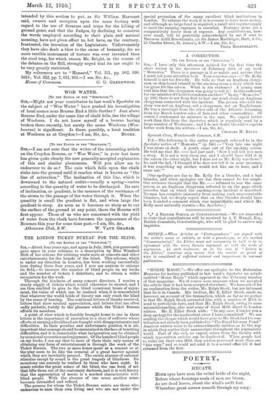[TO THE EDITOR OF THE "SPECTATOR. "] • am not sure
that the writer of the interesting article on the Croydon Bourne, or " Woe Water," in your last issue has given quite clearly the now generally accepted explanation of this and similar phenomena. Will you allow me to endeavour to do so ? The rain which falls upon the chalk sinks into the ground until it reaches what is known as "the line of saturation." The inclination of this line, which is downward to the natural outlet—usually a spring—varies according to the quantity of water to be discharged. Its rate of inclination, or gradient, is the measure of the resistance of the strata to the passage of the water through it. When the quantity is small the gradient is flat, and when large the gradient is steep. As soon as it becomes so steep as to cut the surface of the ground at any point, there the Bourne will first appear. Those of us who are concerned with the yield of water from the chalk have foreseen the appearance of the Bournes this year for some time past.—I am, Sir, &c.,














































 Previous page
Previous page